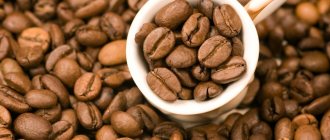Coffee trees have a limited growing range. They bear fruit only near the equator - no further than the tenth southern and tenth northern parallels. The areas where coffee grows form the so-called coffee belt. The air temperature here does not drop to the destructive level of 0 °C. Humidity, precipitation, soil composition, and altitude also matter.
Countries that have favorable conditions for the growth of Arabica and Robusta produce them for domestic consumption and for export.
Where did the first coffee drink appear: homeland and history
The first producer of natural coffee beans is Africa, and to be more precise, the country of Ethiopia. High-quality Arabica varieties - Jima and Harar - are still cultivated here.
Ethiopia is considered the birthplace of coffee
The fruits of coffee bushes have an excellent aroma and high quality. The variety acquires such characteristics due to a suitable climate.
The manufacturer dries the fruits naturally, under the scorching sun, and only after that removes the grains from the outer shell. The whole process takes approximately 2-3 weeks. Only several centuries later, the variety came to Brazil, where it began to be actively grown. Compared to Ethiopia, Brazil is somewhat inferior in the production of raw materials for the drink in terms of quantity. Nevertheless, experts recognized it as the drink’s second homeland.
Collection of coffee berries
Beverage Discovery Legend
The invigorating drink was first noticed by the shepherd Kadim, who repeatedly allowed his herd of goats to feed on coffee leaves. After this, the animals became active and strong. From then on, man began to try to create a drink from the plant. We used dried leaves and stems of bushes. Later we learned how to dry and brew the aromatic skins of grains. Later, humanity reached the core.
Watch a video about the history of coffee.
In the 16th century, it was proven by a famous pharmacist from Yemen that it was dried and ground grains that gave a feeling of vigor and a surge of strength after drinking the first mug.
Information! At first they drank the drink without sugar. Today, it is in this form that the drink is considered enriched with nutritional enzymes and natural. Women were the first to drink sweet coffee, since few of them like the bitter taste.
How does a coffee tree grow?
Plants are grown on plantations located at an altitude of at least 1000 and a maximum of 2500 meters. To understand where coffee comes from, you need to consider this process step by step:
- The seeds are processed and placed in containers to allow them to germinate. The appearance of the first shoots is observed after ten weeks.
- When the seedlings reach a height of five centimeters, they are transplanted into larger containers and moved to a greenhouse.
- For 6-12 months the plant is kept in greenhouse conditions. During this period, its height reaches at least thirty centimeters. After this, it is moved to open ground. It is extremely important that the sun's rays fall on the tree at an angle.
- The plant blooms for the first time closer to three years of life. The flowers are white, similar to jasmine. Fruits are not always set during this period. Often the appearance of berries is noted after a year.
- Flowering occurs within a maximum of two days. After this, the petals begin to fall off and fruits begin to set. Visually, they are similar to cherries and have the same size, shape and color.
- A full harvest is harvested when the tree reaches five years of age. The berries take on a purple or reddish hue.
- The duration of fruit ripening directly depends on the variety. Some take eight months, others eleven.
Harvest dates vary in different regions. If in Brazil this is the period from May to September, then in South America - from October to March, and in South Africa - from the last days of October to April.
The tree can reach nine meters in height. The largest yields can be obtained from the eighth to the fifteenth year of plant cultivation. Subsequently, productivity decreases, but fruiting does not stop until fifty years.
Top 10 leading countries in coffee production
The largest coffee producing countries grow different varieties and export them to other countries. From there they are sold as soluble and insoluble packaged drinks. Who is leading in this area?
Countries producing the most coffee
Brazil
The undoubted leader in growing different varieties. In addition, Brazil produces its own national drink. The coffee bean harvest level is over 12 million bales. The country produces 1/3 of the world's total grain volume. Main varieties: Serrato, Bourbon Santos, Bahia.
Colombia
Every year the state produces about 10.5 million finished products. In the area of two ports in the Atlantic and Pacific regions, the country has very high soil moisture and optimal climatic conditions. Therefore, this type of invigorating drink turns out to be soft and aromatic. This is exactly what the brewed drink tastes like. Famous varieties are Supremo Medellin, Bogota, Excelso.
Indonesia
It ranks second in terms of the number of coffee beans grown. In total, the number of bales last year was 6.7 million. From the 17th century until now, Indonesia has been considered a successful plantation industry. Various varieties of Java coffee are grown on the islands and in the Indonesian archipelago. The following varieties grow in the country: Sumatra, Sulawesi, Java.
Vietnam
The number of grains ready for delivery amounted to 5.8 million bales. The first varieties of the drink appeared in Vietnam back in the 1860s. Then local farmers decided to start cultivating grains themselves. Over the course of several years, productivity increased sharply, which led to reason to think about the low quality of plants. The main variety grown is Robusta.
Provinces of Vietnam where coffee is grown
Read on our website: varieties of coffee from Vietnam.
Mexico
There are about 100 thousand black coffee producers in the south. The drink was first brought to the state at the end of the 10th century. Mexico ranks second in grain exports abroad. Types of varieties grown: Altura, Pluma, Liquidambar MS.
Ethiopia
The annual coffee production in Ethiopia is 3.8 million bales. In addition to production, active exports to other countries are carried out. For the first time, raw materials for the drink began to be grown in the city of Kaffa, hence the name of the plant. Types of cultivated varieties: Sidamo, Harar.
Coffee growing regions in Ethiopia and planting types
India
The state took sixth place in the ranking position. According to the production results for the past year, about 3.8 million bales were counted. After the first variety of grains was grown, it was transported for cultivation on the farms of Eastern Arabia. To this day, the authorities control the quality of plant varieties and their fruiting. Main types of coffee: Malabar Monsooned, Mysore.
Guatemala
The highest grades of coffee are grown on volcanic slopes. These are ideal conditions for the growth of grains enriched with incredible taste and aroma. The first people responsible for cultivation in the region were German emigrants. Today, about 3.5 million bales are harvested from plantations. Cultivated varieties: Huetenango, Atitlan.
Ivory Coast
Today the country of origin occupies the penultimate place in the ranking. The harvest amounted to 3.3 million bales, which is significantly less than in the 90s. Due to enormous competition, the quantity of exports began to decline, which affected the quality of raw materials. Now farmers grow only the Robusta variety.
Uganda
The country annually harvests 3 million bales of coffee. This is the only industry in the state. Uganda specializes mainly in growing the Robusta variety, but in some areas there are Arabica plantations.
Watch the video: The difference between Robusta and Arabica.
Coffee producing countries make good profits by supplying various types of coffee.
Mexico - 234,000 tons
In 2016, Mexico produced more than 234,000 tons of coffee beans. The country predominantly produces high-quality Arabica beans grown in coastal areas near the border with Guatemala. Mexico accounts for the majority of US coffee imports.
In the 1990s, Mexico's coffee production experienced a crisis as the International Coffee Agreement was dissolved and world coffee prices and export quotas were no longer strictly controlled, resulting in Mexico's inability to compete in the world market. This decline in coffee prices and production led to loss of income and social problems throughout Mexico. While coffee production declined in the 1990s and into the 2000s, robust demand from the United States led to a recovery of the Mexican coffee market from a record low of 1.7 million bags (60 kg) in 2005 to 4. 0 million in 2014.
Other coffee producing countries
There are about 80 states that are engaged in the cultivation of plants. Almost all areas are located in the “coffee belt”. This means that the region has the most favorable conditions for such farming. In this section we will answer the question in which countries coffee is grown, besides the leading ones.
South American countries
Countries that are distinguished by high supplies of grains include Ecuador, Venezuela, Peru, and Paraguay.
America is considered a large-scale producer, despite the fact that about 70% of the total harvest is consumed by local residents. Coffee consuming countries in this continent have record levels. Depending on the region where the coffee bean bushes grow, even the same types will have different tastes. Coffee in the Arab countries of the northern part of the continent has some differences in taste.
Which countries drink the most coffee?
Central American countries
Most coffee grows in Honduras. The countries of Nicaragua, Costa Rica, Panama, and El Salvador also have large harvest volumes. Geisha, Finca, and Tarazu varieties are grown in these areas.
Asian countries
Indonesia ranks second after Vietnam in the region. New Guinea and Thailand are also involved in cultivation. It is the Indonesian varieties that can have a specific taste of weeds and soil. In some areas of the country, the country's black coffee may smell like tobacco. Sumatra Mandelin, Java Arabica, and India Plantation are grown here.
African countries
Tanzania, Zimbabwe, Madagascar have plantations for growing coffee at altitudes from 1100 to 2000 m above sea level. Arabica in these regions has soft chocolate and wine tones. A variety that grows in the southern part has a slightly floral taste.
African countries where coffee is grown
India - 348,000 tons
In 2016, India produced 348,000 tonnes of grains. Not everywhere in India there are conditions for growing coffee beans - most of them are in the hilly areas of the southern part of the country. The beans are grown by small producers in the monsoon rains and are often planted with spices such as cardamom and cinnamon, which give the coffee its spicy taste and aroma. In 2004, the Indian coffee brand Tata won three gold medals at the Grand Cus De Cafe competition. Since coffee is not as popular as tea in India, 80% of the country's coffee production is exported, with Europe and Russia being the main buyers.
Which countries are considered the largest coffee exporters in the world?
The South American continent exports half of the world's grain volume. More than 50 million bags of coffee are exported from Brazil annually. Coffee producing countries around the world are gaining immense popularity due to their large harvests and regular supplies.
Countries exporting green and roasted coffee.
Speaking about Asian countries, Vietnam occupies the leading place in the supply of grains to all parts of the world. Liberica is grown in the Philippines, which is classified as an elite variety of drink and supplied to the Middle East.
In Australia, only one drought-resistant variety is found; almost the entire crop from the “coffee belt” of the planet is supplied to this region. Massive exports come from here. Therefore, Australia is one of the world's largest exporters of coffee beans.
We recommend reading the article on our website: coffee made from animal droppings, made in Vietnam.
Rating of coffee producing companies
First of all, here you need to answer the question of how they drink coffee in different countries. Some people use a Turk, some a French press, others use a soluble sublimate for brewing with boiling water.
Coffee classification
Coffee bean producers
The bean product is considered the most natural and is valued by real coffee lovers. The brands that provide quality are the following brands.
- It is famous for its exquisite quality and has delighted its connoisseurs for several decades. The coffee from this company has a pleasant aroma and a sour aftertaste.
- JULIUS MEINL. Product of Austrian origin. The coffee is evenly roasted and has no bitterness in the drink after brewing. The rich taste is achieved by proper processing of the grains.
- To create this product, whole Arabica beans are used. The product has five degrees of roasting, so it acquires an unforgettable bright taste after steaming.
Ground coffee producers
- The company offers quality processed coffee throughout the market. The finished drink acquires fruity notes and a pleasant aftertaste of chocolate.
- LIVE COFFEE. The beans are roasted according to a special recipe. The drink has the aroma of bourbon and chocolate.
- Produces coffee in Naples. The taste of the drink has sourness. Made from high quality Arabica beans.
Producers of ground coffee in the Russian Federation
Manufacturers of instant coffee
- Suitable for connoisseurs of natural coffee who do not have free time to brew. Roasting is carried out using special alpine technology.
- CARTE NOIRE. 100% natural Arabica is used in the production of the product. Due to hermetically sealed packaging, the aroma of coffee is preserved for a long time.
- Nescafe. Soluble base for an invigorating drink. The production complies with European quality.
Rating – which brands' coffee is the most invigorating?
Indonesia - 660,000 tons
Although it may not be as well-known as a leading producer around the world, the country of Indonesia produced more than 660,000 tons of coffee beans in 2016. Indonesia has chosen quantity over quality because the climate is better suited to producing the lower-quality Robusta variety (less prized than Arabica beans from countries like Brazil and Colombia). However, despite this, the country has an ideal geographical location for coffee plantations, as it is close to the equator and has numerous mountainous areas well suited for coffee production.
Coffee production was introduced to Indonesia by Dutch colonists, and production continued after colonization as Indonesia's climate is well suited to the plant. Coffee plantations currently cover more than 1 million hectares of Indonesia, with more than 90% of the arable land being cultivated by small-scale producers.











